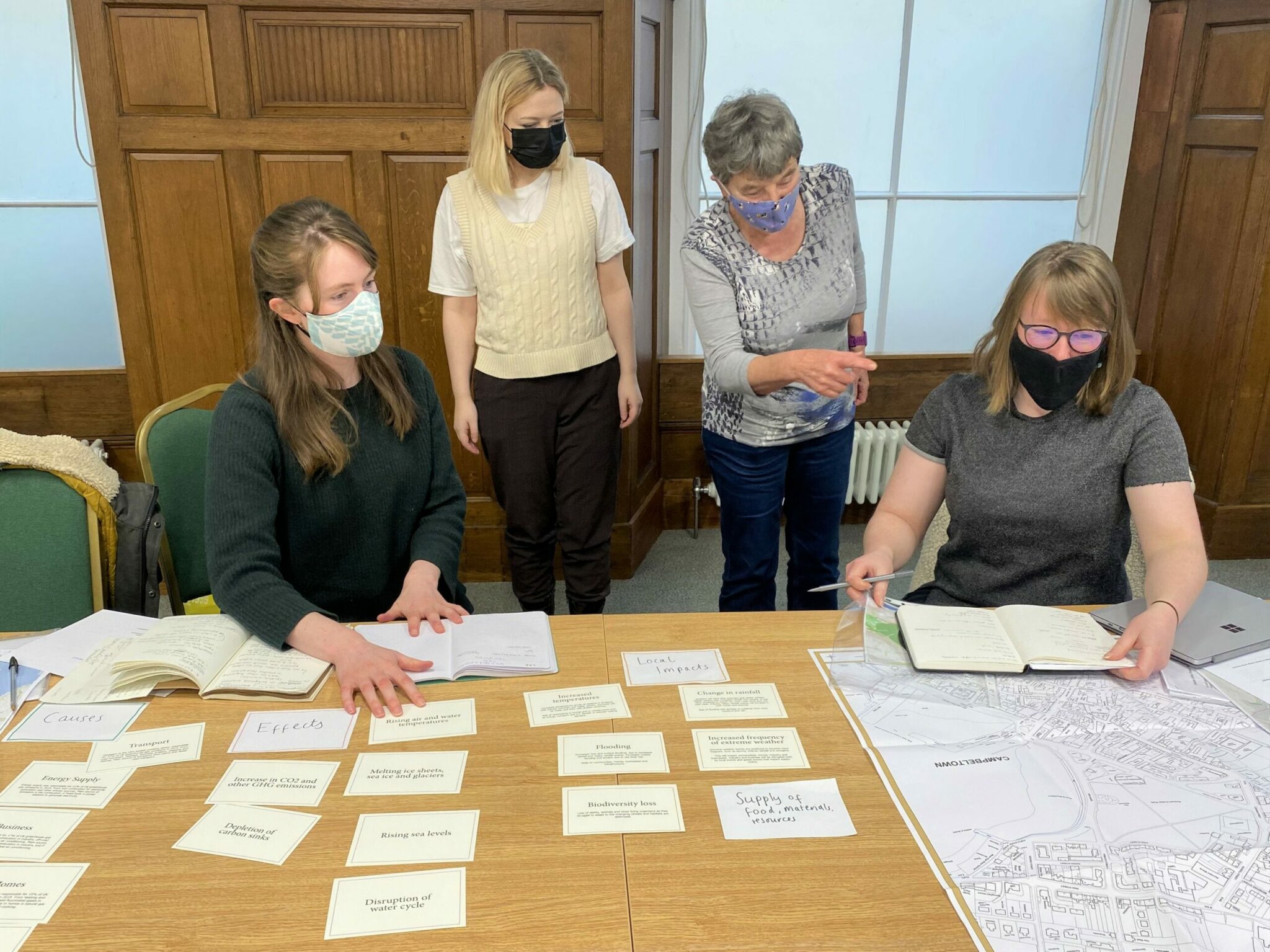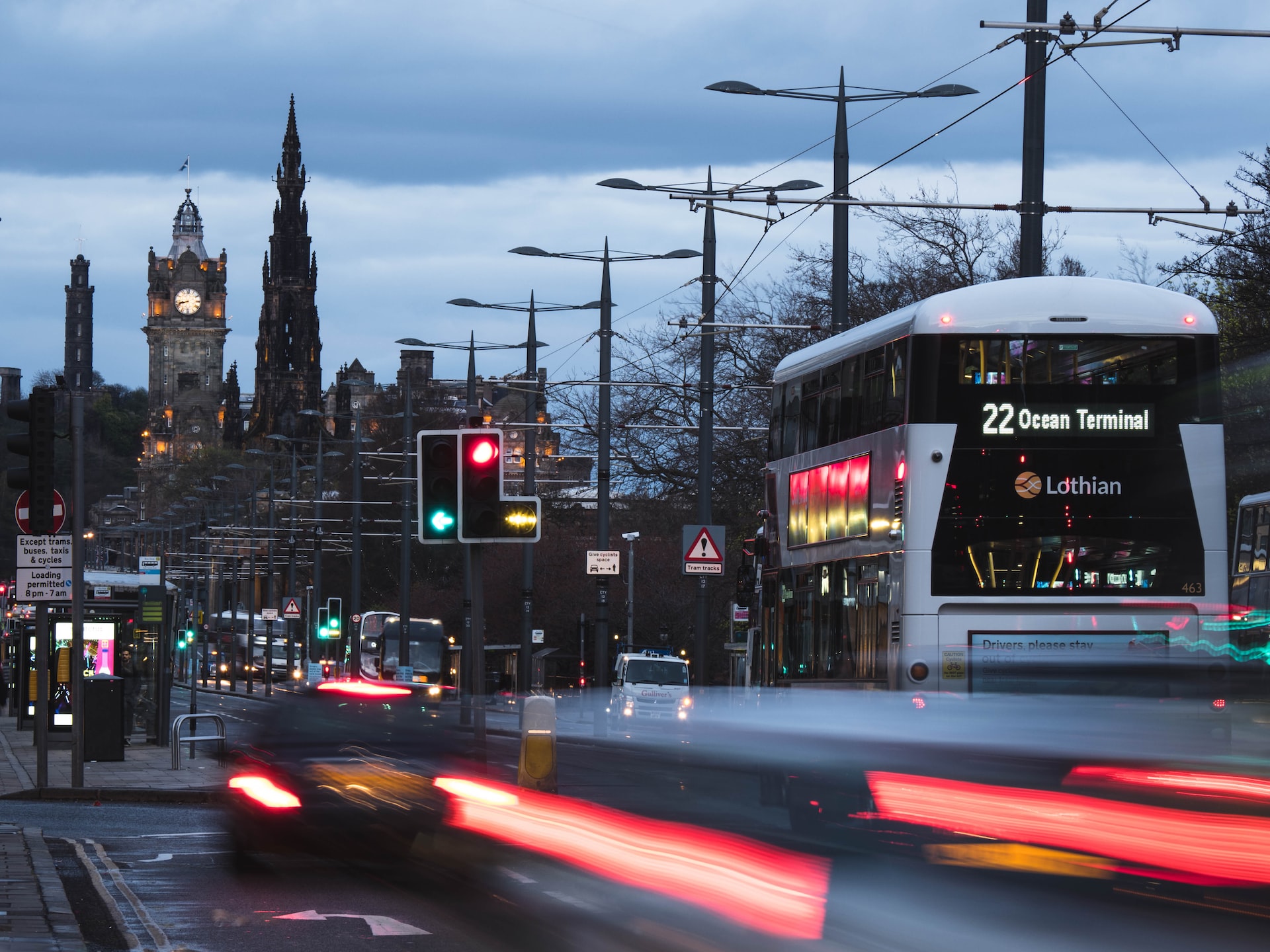Six ways to reduce our emissions in Scotland

Scotland's climate is changing. From flooding to coastal changes and extreme heat to storms, the fluctuations in our climate will continue to negatively impact our national infrastructure, economic future and day-to-day lives.
To tackle the changing climate, the Scottish Government has set a target for net zero emissions of all greenhouse gases by 2045. And reducing our emissions is one of the ways we can work together to mitigate the adverse impact our actions have on the planet.
We've pulled together a series of six articles around the topic of reducing our emissions. You can click on the links below to navigate to the selected section.

Housing and greenhouse gas emissions in Scotland
Scotland's housing is a key contributor to greenhouse gas emissions. This article looks into data that shows the impact our houses' have on our climate and outlines the legislative drivers to tackle the problem.
Published on the 19th of February 2018
Image credit: Ewen Weatherspoon
Currently, there are 2.58 million dwellings in Scotland, most of which are occupied, with 3% being empty and 1% second homes. The Residential sector covers all of Scotland's housing, older and new, including owner-occupied, private and socially rented housing, located across the country.
In 2015, the latest year data is available, emissions from the Residential sector were 12.7% of the total emissions in Scotland, increasing by 3.0 per cent since 2014. The main driver for this increase was the combustion of fuel for heating, reflecting cooler mean temperatures in 2015 compared to 2014. The overall trend since 1990 shows a decrease in emissions, which is good news, but we can do better.
Climate Change Plan
In fact, we need to do better. The Climate Change plan will be published in February and will explain how the Scottish Government intends to meet the emission reduction targets until 2032.
The draft Plan, which was published last year, provides the strategic framework for our transition to a low-carbon Scotland and includes policies and proposals to reduce emissions from housing as well as other sectors of the Scottish economy.
The other sectors are:
- electricity generation
- transport
- services
- industry
- forestry
- peatlands
- waste
- agriculture
The policy outcomes for the Residential sector as identified in the draft Plan are:
- Improvements to the fabric of Scotland's domestic buildings result in a 6% reduction in their heat demand by 2032; and
- By 2032 80% of domestic buildings' heat is supplied using low carbon heat technologies.
Greenhouse Gas Emissions Targets
While these targets may appear challenging, it would be helpful to note that the Climate Change (Scotland) Act (2009) has an interim target for reduction of our greenhouse gas emissions by 42% by 2020, and a 2050 target of 80% compared to a 1990 baseline for most gases.
And this is not the full picture: The Scottish Government intends to introduce a new Climate Change Bill with even more ambitious targets: increasing the 2050 target to 90% emissions reduction, and making provisions for a net-zero greenhouse gas emissions target to be set when the evidence becomes available.
What does that mean for housing in Scotland?
Housing will have to make a significant contribution to Scotland’s commitments to reduce our energy consumption and our greenhouse gas emissions and the key factors to achieve it will be improved design and energy efficiency.
Our Materials Library is a good place to start when researching low-carbon and energy-efficient building materials and methods.

Heating our homes
Space and water heating are responsible for most of the emissions from homes across Scotland - what can we do to reduce our emissions? Find out how in this article.
Published on the 15th of March 2018
Image credit: Alex Perz on Unsplash
Space and water heating are responsible for most of the emissions from homes across Scotland. Between 2014 and 2015, the latest year data is available, the total emissions from households in Scotland increased by 3.0 per cent, reflecting cooler mean temperatures in 2015 compared to 2014. For 79% of Scottish households mains gas is the primary heating fuel, with electric heating, oil, and other fuels such as biomass following in descending order.
Assuming we cannot affect the weather, what can we do to affordably heat our homes and reduce our emissions now and in the future?
Emissions from housing
The recently published Climate Change Plan explains how the Scottish Government intends to achieve significant improvements to the energy and emissions intensity of residential buildings by 2032, which is the period covered by this Climate Change Plan. It won’t come as a surprise that initially this will be through energy efficiency improvements, and from 2025 onwards through increasing the proportion of buildings using lower carbon fuels for heating.
Emissions from homes built now in Scotland are 75% lower than for buildings constructed to the standards applicable in 1990 thanks to our Building Regulations for Energy. While this is a significant improvement, it is only part of the picture of housing in Scotland where:
- new homes represent only a small percentage of our housing stock, with 80% of housing in use today expected to still be in use in 2050; and
- housing has the biggest impact on our carbon footprint (otherwise known as our consumption emissions), even more than transport.
How can we reduce our heating needs and emissions?
By focusing on energy efficiency improvements the Climate Change Plan anticipates that we will be using less energy to heat our homes, and therefore we will reduce our emissions. Better insulated walls and lofts, along with the use of smart meters and programmable heating controls will help initially, in conjunction with the continued deployment of low carbon heat in off-gas properties and other sensible options in on-gas properties.
From 2025, the pace of emissions reduction will have to increase if we are to meet our 2050 target of reducing our emissions by 80%. That means that a significant proportion of the heat to on-gas buildings will be supplied through lower carbon fuels, including electrification of heat.
Current energy prices mean that gas is the cheapest heating fuel for many households. Running costs for heating homes in the future will depend greatly on energy prices at that time, which cannot be predicted with certainty in the long term.
However, already in 2015 energy efficiency was designated as a National Infrastructure Priority. Scotland’s Energy Efficiency Programme (SEEP), which is an integrated approach to improving energy efficiency and supporting decarbonisation of the heat supply across the residential (and non-domestic buildings) sectors is currently being developed.
In anticipation of the SEEP route map which will be published later in 2018, our Materials Library is a good place to look for materials and methods that can improve the fabric and energy performance of our homes.

Scotland’s towns and cities
This article is about the opportunities for the positive contribution that our towns and cities represent toward meeting our emissions reduction targets.
Published on the 23rd of April 2018
Image credit: Connor Mollison (mollison.co)
Buildings, streets, the spaces in between and the ways people use them or relate to them, in other words, the built environment system, has a key role to play in supporting Scotland’s ambition to decarbonise the economy and reduce our emissions. While both rural and urban settings affect our emissions, this article is about the opportunities for the positive contribution that our towns and cities represent towards meeting our emissions reduction targets.
How do our towns and cities support reducing our emissions?
The Climate Change Plan (CCP) explains how buildings and transport in Scotland are expected to help us achieve our challenging legislative targets for decarbonisation to 2032. For buildings, the CCP includes measures such as improving the energy performance of our housing stock and non-domestic buildings, initially through increased insulation levels and the use of low carbon technologies for heating and cooling.
For transport, the changes discussed include the increasing use of low emission vehicles, establishing low emissions zones in Scotland’s four major cities, along with the promotion of active travel choices. Our buildings and vehicles will be powered by a largely decarbonised electricity system which will ensure emissions reduction and security of supply through diverse generation technologies, increased storage, smart grid technologies and improved interconnection.
Strategic thinking at the design stage
While these plans will directly affect people in Scotland, the built environment components and the relationships between them, should not be seen in isolation. Through using strategic thinking at the design stage, we can achieve emissions reductions at a macro scale.
Enhancing infrastructure
As we look at improving our buildings, we also have the opportunity to enhance infrastructure, and enable it to support their operation through, for example, low carbon heat networks which can use the energy of wastewater and drainage systems or other locally available resources.
Green spaces
The spaces between buildings can be rethought of as new green infrastructure pockets, which, when linked to the existing or extended green infrastructure network, can affect the travel choices of the local communities.
Routes and links
Existing established routes between destinations can be revisited and reimagined as links between services and civic facilities, promoting quality of life and encouraging the development of active communities. They could for example provide opportunities for active travel, different public transport routes with low emission buses and enable the establishment of low emission zones.
Placemaking
Placemaking is a useful way of thinking about how our towns and cities can help Scotland decarbonise. Tools such as the Place Standard can be used to provide people with the opportunity, power and support to talk about their place and use this to inform future action.

The role of construction materials
This article looks at the points where materials selection and specification can support reducing our emissions in Scotland's built environment.
Published on the 30th of May 2018
Image credit: Annie Gray on Unsplash
Building materials affect how buildings breathe, their thermal performance and their embodied energy. As materials age, their appearance, as well as their performance, is affected and this needs to be considered at the design stage.
Replacement, upgrading and maintenance can be challenging when materials are not easily accessible, or in those cases where there is no like-for-like replacement. Indoor air quality, acoustic performance and sick building syndrome are frequently discussed when considering materials, as they can affect the health and productivity of the building occupants.
Specifying construction materials
To an extent, technological advances and the manufacturing of innovative products can help respond to these challenges. However specifying materials considering their thermal properties, such as their thermal transmittance (u-values), and ensuring they are properly detailed to avoid thermal bridging at junctions, are key factors to creating a comfortable environment and reducing the heating needs of the internal spaces.
While heating has the most significant contribution to the greenhouse emissions of buildings, materials can support mitigation in other ways too: for instance by considering whether they are renewable like timber or finite like stone. Within that, it is worth exploring the possibilities of reusing them or recycling them to minimise construction waste, and also of upscaling lesser quality source materials to produce higher quality ones, as is the case for timber I-Joists for example.
It is worth noting that natural building materials require less energy-intensive processes to achieve good performance levels compared to manmade ones, and that is reflected in their embodied energy. Whether they are produced locally or imported also has a role to play: locally sourced materials need to travel less between the location where they are produced and their destination and could help reduce our carbon footprint. This is not a lesser concern, as according to the recently published Climate Change Plan, housing alone is responsible for 32% of Scotland’s carbon footprint.
Where to look for information and support
A good source of information on construction materials is the Green Guide online, by BRE where building materials and components are assessed in terms of their environmental impact across their entire life cycle - from ‘cradle to grave', within comparable specifications.
Architecture and Design Scotland has recently launched an online resource complementing its Library of Sustainable Building Materials which is based at The Lighthouse, Glasgow. This is produced in partnership with BRE, CSIC, Zero Waste Scotland and Forestry Commission Scotland and showcases sustainable, traditional, innovative, recycled and low-carbon building materials.
Scottish Government provides financial and technical support which is targeted to the poorer performing existing homes and intends to increase the take-up of home energy efficiency measures, reduce fuel poverty, while also help reach our emission reduction targets.

Scotland’s communities and climate change
This article explores the opportunities and challenges that lie ahead, alongside Scotland's communities' continuing role to help reduce our emissions by 66% by 2032.
Published on the 10th of July 2018
The continuing role of Scotland’s communities to help reduce our emissions by 66% by 2032 has been highlighted in the past few months in the Planning (Scotland) Bill, the Climate Change Plan and the new Climate Change Bill and the Scottish Energy Strategy. In this article, we’ll provide an overview of the opportunities and challenges ahead.
The planning system
The Scottish Planning legislation is currently reviewed and the proposed Planning (Scotland) Bill looks to strengthen the contribution of the planning system to inclusive growth and empowering communities. While we won’t know the final content of the new Planning legislation until later, it’s accepted that decisions about “place” can support low carbon lifestyles and that Scotland’s transition to a low carbon economy can only be achieved with everyone’s input.
The Planning Bill includes a new right enabling communities to prepare their own plan for their place - this creates opportunities for communities to use the planning process when considering how to access funds for change, such as the Climate Challenge Fund.
Action on climate change
The Climate Change Plan (CCP) will be a fundamental information source for the preparation of the next National Planning Framework and Scottish Planning Policy, which is expected to be published in 2020. Decarbonising our economy, as set out in the CCP, intends to support the delivery of an inclusive, socially just transition, based on equal opportunity, a fair and inclusive jobs market, regional cohesion and safe and secure communities. Communities and individuals will have to change behaviours to support these improvements and Climate Conversations across Scotland will help encourage discussion about climate change among people who do not generally talk about it.
In the meantime, a new Climate Change Bill has been introduced to Parliament, with an ambitious target to reduce our emissions by 90% by 2050. Having said that, the latest statistics reflecting our progress towards reducing Scottish emissions, show that we have already reduced our emissions by 49% from the 1990 baseline. Communities need to be a part of the decisions required to achieve this transformative change in our towns and cities.
Action on energy and energy efficiency
One of the six priorities of the Scottish Energy Strategy is to empower communities by supporting the development of innovative local energy systems and networks. At the same time development of new technologies and the decarbonisation of heat are expected to create economic and social benefits, as surplus industrial heat is redirected to communities to heat homes, healthcare facilities and schools.
More specifically the Energy Efficient Scotland programme sets out the journey our homes, businesses and public buildings will take to become more energy efficient. It will also guide the decisions that we will be making, with our partners, over the next 20 years. Communities and individuals can put forward their views through the two consultations which are open until 27 July 2018.
Enabling communities
Health and wellbeing are linked drivers at an individual and policy level. Green infrastructure and public transport, along with low emission zones, can improve health outcomes and reduce traffic and pollution that affect our wellbeing, while better quality, more attractive and safer places can encourage more active lifestyles and support the reduction of our emissions.
We have been supporting Scottish communities to engage and affect change in their places in various ways, through Climate Action Towns, town centre living, the Place Standard tool, and improving existing places through co-production to name a few. This approach is based on the realisation that where communities are empowered, it is possible to achieve improved, more responsive services, which are better linked to the local needs and deliver better outcomes for the communities themselves.

Scotland’s public services
How do the trips we need to make to access public services impact our Greenhouse Gas Emissions and Climate Change?
Published on the 16th of August 2018
Image credit: Eric Veiga on Unsplash
According to the Scottish Greenhouse Gas Emissions in 2016, the latest year we have information on, road transport was the largest source of emissions in Scotland, with emissions increasing by 7 per cent between 1990 and 2016. This is due to a growth in activity over the period, offset partly by improvements in the efficiency of vehicles.
The Climate Change Plan (CCP) anticipates significant decarbonisation of transport by 2032 with emissions reduced by 37% over the lifetime of the Plan. But what does that mean for the trips we need to make to access public services?
Accessing public services
Accessing public services, whether they are schools, social services or health facilities in the area where we live is part of our routine. They are a key part of our neighbourhoods, towns and cities, and their location and the types of transport available impact our emissions. Introducing low emission zones to improve air quality and making our towns and cities friendlier and safer spaces for cyclists and pedestrians are amongst the proposed interventions in the CCP to address the rising emissions.
For example, some services can be delivered remotely, or even digitally, to remove the need for travel to a physical location and subsequently reduce our emissions. That is currently explored in health provision, for people who want to and can, live at home independently, and for those who need formal care delivered.
Self-care and care with the support of friends and neighbours, alongside technologically assisted care, allow people to maintain their independence at each level of the care spectrum and remove the need for trips to facilities that may be hard to reach, besides allowing a wider choice of care for those who need it. We are engaging with partners to develop and peer review work on town centre living, to help build up a greater understanding of the dimensions that caring places might include.
The location of public services concerning existing or proposed new housing in a place can impact the travel patterns and choices people make. This is true for the recipients of the services, as well as those who provide them; teachers, carers, supporting staff and professionals alike.
By understanding the flows between the places where we live and the public services, we will be in a better position to review the need for relocation, merging of facilities or new provisions, along with the options for active travel through places that work on a social level and encourage alternatives to the car.
How can we help?
At Architecture and Design Scotland, we believe that well-designed buildings and places make the best use of our resources and create places that help people and communities to flourish. The better a place works, the more it sustains services and amenities.
We are here to help make places better and are passionate about promoting design that meets everyone’s needs. We offer free resources and advice to anyone involved in shaping our places. You can visit the how we can help page for more information.
Header image credit: Matthias Heyde on Unsplash
